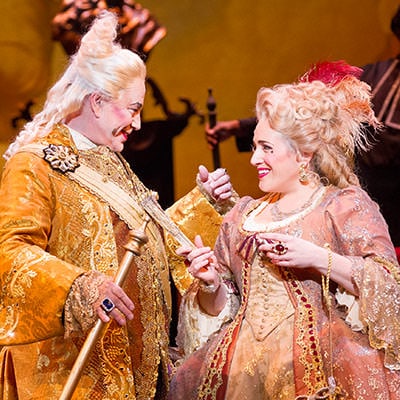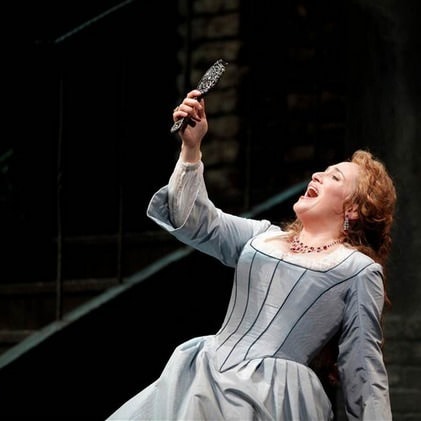Washington National Opera’s revival of John Pascoe’s production of Manon Lescaut, Puccini’s passionate opera, had a thrilling opening tonight at the Kennedy Center. Patricia Racette triumphed in her role debut as the doomed heroine Manon, in a production that is not to be missed.

Manon Lescaut was Puccini’s first popular opera and it introduced the first of his famous tragic heroines. Manon is on her way to a convent when she meets the young Chevalier des Grieux. Dashing, yet poor, he convinces her to escape to Paris with him. Eventually though, Manon is lured away by the Geronte de Ravoir with the promise of riches and jewels. However, her true feelings for her first love come through when des Grieux suddenly reappears. All is not smooth sailing though: her conflicting desires for her love and for the luxury of riches send her on a journey of despair to far-away America, with disastrous consequences.
Patricia Racette shines as the titular Manon. Her voice is rich and warm, with great nuance, in contrast to the slightly harsher, slightly colder yet equally strong voice of Kamen Chanev (Manon’s lover, the Chevalier des Grieux). Racette’s aria near the beginning of Act 2 “In quelle trine morbide” prompted some in the audience to yell a well-deserved “brava!” Yet Racette’s glorious voice is complemented by her exceptional acting: her Manon in Act 1 is girlish and innocent, quite a contrast to the tragic Manon of Act 4. Racette truly brings Manon to life.
Similarly, Chanev (the Chevalier des Grieux), Jake Gardner (the Geronte de Ravoir), and Giorgio Caoduro (Lescaut) sang beautifully and were equally adept at creating full and developed characters on stage. While at times they were overpowered by the (rather loud) orchestra, their voices too were skillful and beautiful as they made their way through Puccini’s melodic score. Chanev’s opening aria “Donna non vidi mai” was passionate and heartfelt, as the material demands, and Chanev’s voice soared. The final duet in Act 4, “Fra le tue braccia, amore,” handled masterfully by Racette and Chanev, was beautiful and very moving, (as indeed were all the arias tonight). Caoduro, as Manon’s brother, was conniving yet charismatic, with a clear, strong voice that worked very well in “Poiché tu vuoi saper” with Racette.
Yet it is not solely through the skill of the singers that Manon Lescaut was so powerful and moving. Director, Set Designer, and Costume Designer John Pascoe’s innovative vision of Manon comes to life with lush, detailed sets and costumes that enhance and support the emotions onstage.
We are constantly reminded of the impending tragedy by the ever present guillotine blade hanging over the stage, a surprisingly effective touch. The pastoral, almost impressionistic set of the first act was contrasted very strikingly with the harsh, cold palace set of the second act.
Likewise, Lighting Designer Ruth Hutson and Choreographer Coburn Bruning added much to the production. The deep, blood red lighting in the final act, for example, served to heighten the despair and anguish the characters were feeling. Likewise, the simple, girlish costume Manon wears at the beginning contrasts greatly with the splendor, almost gaudy gown she wears as a courtesan, and while Racette wears both well, the audience cannot help but realize how much more elegant the first gown was. The effeminate costumes of the Geronte versus the uncomplicated costumes of des Grieux also serve to underscore the great differences between the two characters.
And of course, the Washington National Opera orchestra, under the direction of Philippe Auguin, played superbly.
Manon Lescaut oozes with passion, and is filled with larger-than-life heroes and villains. Washington National Opera is more than equal to the task of bringing Manon to the stage in a relevant, exciting, and beautiful way.

Running Time: Two hours and 45 minutes, including two-twenty minute intermissions.
Manon Lescaut plays through March 23, 2013 at Washington National Opera at The Kennedy Center Opera House – 2700 F Street, NW, in Washington DC. For tickets, call (202) 467- 4600, or purchase them online.




